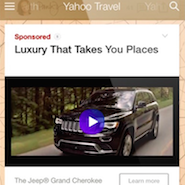There are warning signs on the horizon for native ads – one of mobile advertising’s success stories in 2015 – with fewer marketers planning to use them as frustration with the format grows, according to a report by Trusted Media Brands Inc.
The survey of 300 marketers and agencies about which mobile advertising formats they plan to invest in found that while 50 percent of marketers used native ads in 2015, only 45 percent plan to do so this year. Marketers complain that native ads are hard to measure, are difficult to produce and often have a sell through rate of 5 percent or less.
“Video is commanding CPMs on mobile that are higher than video ads on desktop for some publishers,” said Rich Sutton, chief revenue officer at
TMBI, formerly Reader’s Digest Association.
“While [native will] be a leader in 2016 – it’s trending down year over year,” he said. “It’s possible that native could come under pressure since it is perceived as challenging to produce and measure.”
Banner ads lose steam
Looking more closely at preferences, the survey found that native is the preferred mobile ad format for marketers in 2016, at 42 percent. For agencies, the top format is pre/mid roll video at 52 percent.
Another key finding is that mobile display banner ads are losing confidence, with 45 percent planning to use them in 2016, down from 63 percent last year.
Rich media also appears to be losing some steam, with 39 percent planning to use it in 2016, down from 46 percent last year.
“In 2016 marketers and their advertising agencies are saying they are going to cut back on mobile banner ads by at least 20 percent,” Mr. Sutton said. “What’s next?
“In addition to rich media and interstitials, native and video ads will rule mobile in the next 12 months,” he said.
Display interstitials gain
One format that is growing is display interstitials, with 37 percent planning to use them this year, up from 29 percent.
Another growth area is interstitial video, with 37 percent planning to use them in 2016, up from 28 percent.
There is also growing interest in interactive overlays, with 35 percent planning to use them in 2016, up from 28 percent.

Zalora is using Google's new Interactive Interstitial ads
Interest is also growing the IAB Rising Stars formats, with 31 percent planning to use them this year, up from 15 percent.
Native advertising was hailed by both marketers and agencies for providing better brand awareness and engagement scores. Survey respondents perceive many benefits to mobile native ads, with 44 percent saying they are less intrusive, 32 percent insisting they increase brand awareness and 31 percent pointing to their better engagement and interaction rates.
Less intrusive formats
Marketers and agencies do not see eye-to-eye across the board when it comes to the benefits of native advertising. While 31 percent of agencies say native ads provide a more authentic brand voice, only 23 percent of marketers agree with this. Conversely, 33 percent of marketers think native ads provide a better user experience while only 23 percent of agencies agree.
Where native ads fail includes in driving a higher click through than desktop, named by only 19 percent of respondents. Additionally, only 17 percent said lead generation is a benefit of native ads.
Marketers and agencies agree on the top benefits of mobile video ads, with 47 percent saying they increase brand awareness and 34 percent that they provide better engagement and interaction.
However, 26 percent of agencies point to mobile video ads’ ability to provide a more authentic brand voice while only 18 percent of marketers see this as a benefit. Additionally, 25 percent of marketers see lead generation as a benefit of mobile video ads compared to just 17 percent of agencies.
“In 2016 marketers should spend more on mobile and focus on the less intrusive video and native ad formats to give their message an authentic brand voice, increase brand awareness and engagement, and reach consumers at both the top and bottom of the purchase funnel,” Mr. Sutton said.
{"ct":"QgYIJAFDa+FzFg0D41FQ1clieGyRpjO+GLzD3ohgYQPnF\/o1yF1HVBaUpPhZuZtVUXvYa1G4mlS1J7LJK+Se4WwsNqxWe349EidKTYyNlycQXf6ojdkiJrxNXzaj6DOlHRTcnzXcJddzBa0sHm5EWgin1u3B27jFOPTEh\/uK7KR88qtJJnmsRMPP\/uduTJkmleLJFXMRHq3c\/R4zYbLiJ3bIDPtXAh523Ow9MhxhABztNxCrUl4RslHM2AlguKyxHJ0piT3\/aAHFDx53ilsQUIfFTBV5XpNybGqwgtkouiTH5d5BtqZ\/I4dcnoTOnyUtyOkRoQ1wxQiXMS0pqwzmITi3E6Hcx4s4b2SVFsNq2pCf\/7szEHXg\/Oj\/zpmwffjfQMVek6ogUceMn+YEJQHOXq+g3mlf0JOVikQgs723j97HQ2a0n+GTx\/4\/pqTKEcPXazy8deBR6E51RJzy0sflp3LBkKfD5V2PekES8sB8c4dCkhQ\/ySbuDPEx6WBzWcD4f2GF1M0nioV1ldQUEtFMJrSI\/1+PGsw29uLW0TvEFS+euzLzB8UnD3B8Eirg\/eLOz\/KTeAH5BzWpE+YYk8cHthoHRMsR\/F1e0\/NiQNk3B6Jl6lmtgTUtqAxVZy5TzsFBsij12SddB2spuRHAyC1VHUZ2U\/d7fh\/+3+aVBNJGI2IBQ2zplV97uQE+o5RIMI6SxGDuU6eG7uqdeYSCFen\/w3XYXvQrDb955aDOnMVIdcjBHjqe1EmMa3RUrVjOcWoHrqNJ2h3j9AIOCbaO\/0SqLjpivnV0eE616ztZMrPHpi3+F8iu4vWbWR0GujqSp4CLwTsriLxirFP9SDT+BxpEBQsDbS30Nntsyzo28zvunm+VrrJhQ5Cp\/JORGh1usrlEsqPSmiwnfdpJctjmVLFMY3OMRxTLPzIKPTsdMSUPD9nfT07zypDBSrIX+WwhYnGagQy4Esb9ATLN\/tgZ+EYzSTsf3YfYe1yD6EnS3ZGHcCm8phIJCU92b5ZqQ8yAIy+YhAVOPKNBNzBrzoL3\/bLXBbVTVA8Ac5r+KsiWycH7Qap3sYFn6397gX4wXd8mqFweE6vKUsRgiWW6rUhgykYZoom4hN71FPi0E8bwf\/VRsv+n\/8kT4WwyP8zYP8byw0d9FWZZDeCQlatdzCQt\/yJs5o55lpzCsc051bjqzCVU7y12JLcct1lO0hDr3w1s\/2C8lB3KAKYvnnzuGOs1GaVMUfLiYsTAaJQaV\/LVJVUhRKZUoRARCywcT4hlUXkQz7GqJ3dv28\/q73Udr0amEwqIC2R9SVKUMxgIr0tTzfHMYYy9527TIAGRT1b7pyqinI5TZkiAz+90ACyDXnExlyutRfdAGLeYcRuAjFXD5gCvcdkVaf3Qa2DPMx0irhMF\/HkB0uWSenstdzgseUureXc1sxnbclkjXo0FLWZmPflH+Dpms4MTqDhMv0\/fcr2wzgHvIuGlKys54QlqH94OYzV52+SJScWB0USYr+IvCBqDZjwqqqReA+y8+0AO7NsWVztZMjOayCyXKq+3dVlKl64WqlYay+XBQNjkOeI1aaqc\/aBlufdPCsXO57skpnsZ4iIDiON0ZIw9inqyoES3ejEJ2gKO48o\/tFjmpkc3R6nB0MEFp7WK2Eoe2bLguJQXyeiSKXeT6KI3R+HBJjx+6N7H3\/VeXVtlmfsKGwQLKvARHW8EYrAUQxJo0ZJd3usTBQzCcr33SOsls7BaDkVhd1JqDBP33aYKhUGqogOm932zbbM6RFTIZkgZCYXToJt9wyeJkkDM0iWpFFU89V2IiIZS7jCgeqvx1+Iy2KAosOWbu+NOAoztquxNKQMt9hptpvl58SnmSV9y3Lvps6EzbrUa6p8xhHeW2MQmJPELk8FSmiVKZV0lJIs8hCW+azwL7bLxpyi3iSASI+yNPdVm5l9f7VERQ5vxuwZfGwvhc8oDeK05qp+swyM21eZsj5eT7h09l7597MY4Bij23X7TA7leQ0qBbii9eiH\/ViKalWDxUw2sSftl8l\/q6pUYx79vPOKnfN7CparwAOu\/J1qX9wfBYM7mlS6IF7RMqcA+1iVJqmCLYd7n1TZljGoR6QUg8svgl956sUEp2GDK8Gbg4Yk0B9ZLmIg7VyukUCmw7ImYyZO8UG9zJTI4B0NqiLJm\/SMdAONt1f6e2ZvcyuZTF1D\/odqhCGpcmZULwGObjruVcwXd0xgHha84diPUyOzghT59GmHP4yNzwmIPIG+yrOqamnHKG1uj4S\/tN+vwalpPZGawRsikeHhEZJ\/+EjohSPTFnTNEW0BlKZDnUprCXV486dry3TkSWXZ3uL4QSD5NLe26yQN5gtuHLtCx82CBoRVNJtwIHwy\/fgN3VmYlCq4sJJli4BbEYIwFwHH5PC9Tjx2zKvaPcSdpjpt3yKN7MhVJU8e4hVmXgU6NNm\/rFQIiIDotSmbSJ6jG55Gj0owQzmtnpvDdOIboVP+2ln2inVgkaXPsBqT\/fazkYFpj8jlTpmMow0nqmZZhwSSQYsozNzuGOA\/JlHImkzsqXCXfWE3nyV2AG8nRRtkOI7fLarVMmnx2kLW+xH+we0AIDk6nI9\/KXS5aFpQtYUj7iKe7Ide7uElYTkWgU5Zu1WEi8sL5QEHSWwiuVcXRmo1Vd0wXRVEk9k2As54iZDyVDNjhpM8Wh1MQadpyV0DRaalFB1JxQZH5ZQUIsxX13N2FVTNSePsKsDpGMIMtlgmzfFt33sZOjzlI84UAStmnCck\/g+N\/\/nnzQdAJ9N4HYNMVgZfdT9qvaq5AnvJpkF7DFHQtywAoDjoJ5TnBkvjXvcASQxBgAvnty6uytDsWIJe5zneSYD6G86U8K4c+TYOtcGNH9ZCIbU5uT8\/10YMnOypoYGl2GVIXugkC7K58NXRHQxOZNnNm7O2Yxl45M\/bVvw7JSoTtbYVpS2zpsYbO4jjxgv3uLGLtoXoLpZk69IxQULPmYrsoVIB03KgpAGlTcM1ACVfnqjb53zwTPsyqjf2IuOJ0MIujv2dSLuQn7gBOquwwBdCc5p0FA6gnCwUIVMC5+CZurjv\/hLnSeIxFBz6SYKR\/i7O7uds5oFItpWya2K9yjgd\/qzzBPnWbSuVYAANMC0D\/1d9zFInKMwOpcn0noJ8E+UDU65Hqwu6ivkmITcKQ7JCK3CULwGgIS74a9i1a9YB83ODwl\/vYn+35EXskLO\/aeIVilOzXzVCRaufIKPH3bFts3trwoyPaGwUS57DdJ5qzCpx2904R7+S6MFXS8Sc2u0wh4Iad3IA6FkBQUvDTz2lpTAgx\/bXgn+n5Z0QzWC9s3qB2YseZhQFlFUCHtxvHfVi1qaixzlMXeVfI9x8vQ2YWL26sDz6tez4SHOVxR52H+yFDf\/BtkADBjiGgfJ13oIovPYAlSZ9MA21A8aEfoMCWwFcIJFud+DZA\/jG+S3+baW2AyLREoSI8rvSHLPQe9RACuyGoZi42nZhP5c5RL6CDIHTNuoDXTDtQozvuBTTMqfxeePdchsO9imXN+8807JWJci+417FHkevyswjB+rBKynOMzu8r0HFyxwThs1qodJLbKF\/8ZTtzWvknCcZZ1ty\/eXBc0LeIBQsHP3Qiq4cHqj\/JM5zWx2llMugH7mwKer0HTDi+PYsLNcvJv9Ia\/ZXD3xwHJpEoxkU0nQ7kk1kXvNGKA+WBRhEk9vR8jApeFLaaJyxNZXpI6TE0wUFlvUmp+MyahAohKx4ei8PCghsStRtyaHSJSi1KK3lvMSVMc6qZgOGh6Bs9861\/mqu+hMHH7u8sBhnnBmdTkd1wPqPGp1FABkmowS3ryATyykVNkx3mRrdRfxuCWlf6W65HfSOZQ\/\/6l9ZTPnAlLSrcEXk5qvgQCuQQ+APCJ8GkPTInE\/YxV3dGe2FfN2b6T\/dS7X+i5ilEDEFIXY1dujjg5N4CKRuL5h3AXC0N5exgSaylQuHqtk7nMaTOBlSanzuOC36G\/9DVMHoaE\/aLl38Y2n5Wkml6XVRKWj2dcQS0ucL4tLYyC2Rcv+gQsBervytfbeHiHbYlBhY2YmkHLn7yFYV5zoUdr8DaCKtxCivv6mQ5i+l6kEacdGxTvUCrkO9Xg08SoYyprT0c7uK466HK8APtoDGN6QI6rKSngQVf12Y5vr3etiFHAaJhted+gtaxuMqSf3O4fApA3A8QSoneZc8u1huSLAp7wSyS9hILIBRyF6EWcj4IN4yQ8kWe\/hUZbXicwKLES+DLpffq0b8vcGj5ClUHdY+i7Fcmie\/lpCrnyiQTawKwoifDmJEbQISD4+aNZFJGmzLVWLIrKClC7HDPp3sIZz8W9ZCFXoCmJ+mig0D7ZOb1SzEmOfI2XlLqSD7xYXdmpjOtVIIf1YKxVfZokUIw90+YXYH3OkWwb5Y1Dcj7cvdHJ0dQqswDoGfGPRNhm0Av8Mh11pWkXbVVqoJL\/f0MfcYCWJwLpO2xc89eFYOI7V+BXITIDcpgv4UVhHHPcbUntZj92HDhwqsZNkEFqiOI\/XAgj98U9tJ6KhlPhjN5U9BwfK5FCoA93FWufgrK5sW7ZPoFih7jjTLGvwdrt1JVZy1gF94jmBpppdQ0lzhlqIedS3JgoaRK\/dfdm4Cp34Rxh2Z\/Dxwqz3GnDjXcgtBi5xd8XlxBKIWrbY\/xen0Wq72rouoGa+fnSkz6UxXKdt998eLhvwie\/IDWQ5FvPgHukPITycv73x3ZxJzyXab0FYTjg9yQqQnByEPqxwFatb5WGqAYXIuxjnd81BcHF5swXDNmsRkSeuI9Jbv4VIi0QDjpHz9qaags51D9sYeGk7TV5JrbVo2j\/wAGEvCmBVPlZ8AzLBnCUYYiIDJQB3JMXT9ed0fxUa\/9q\/AuPQvf2P\/uld2XtIPqbYkzWus24\/d4XoLJoUWgqi+mSD\/twiB+d2gEZ76RcokrYLK7es113S6SBAFZLfJUsKWkCsv\/5ObnqZrvnCBTevGOUqrFkcer0RLm2fsjVB66IAicxxb8EkrwLVAo+55esn9QAxeW58wZpN7DrmVHLaN1SCBcBC1Pmy9Hue2+Lm5+11WKUUy3ac3SZnHuiA\/lRTSzSwMoCoXnLELfNCH3da+0NjQ421ejst1y\/zHf51ZpIZxXx6rkAp4Y++a7oOFasf67cD7DAHjdIHmJQzev0mWxGQZy6\/zsyAopdYNJrcKNGRxo1\/CNBe6PIQt+HlhwZUHX9Akn0iYpaZ6paiC0jiNaCHI+Zpy6dxObgxtj5oHZTnLo8KqKBoGUJrLurxHyFTZrdDn0I0NsJpbcXAdc2CfvcjYUrhy\/084n+na3WuJxRuX1qr0HCUxSzgk57YAlvMiAt\/+UsIWGKmf1MZwwKHkQDIDCm0Xby3ZDWhuE3FROqX1IMCtvQlwHbyJSa+SX5eLXfo3Q+BpQtgcS0FS1VXUbp2pRxc\/sYXse6PFVROvuD\/0a2muvdzBWnA5mLqpOKGchf69fdNPwyqpfyoaPZyuthiEr4g\/asU1GSmSp+yzE8rAKMRpimHgLUe1zafbMJQeCzCg9Wpuu7HKzdmF0LEx6O57hUKmA0FlQDKPvI0I1y3vWtLeCp2vKiJeg9IVwjqqkCNquRpfqPB+eGD5lkht7kMPtSvTSOJSXVfb5Dpa8F\/M1tYnZRUUxn9p5NZpC31z4mrxDhOMJPD2BtaC3bv5NxKFzKj+R\/9f9Zi9vPJZGvJe9ZTCBhhfLZ\/Pbt6cZA54f1uNZTsEi2fOvJZhNC9Aelcu2yTIY+XlgLINT+9xEjjuUeatNIDa0nVbZgXiOb0LnaGT7j\/Pd4ZwMuH\/M6yDejnk7IauTXXHoeTVGc+ui6rbvbYiSMTsFA3sEE9OQuSQ8EqQfBIfFdMVvF9A1JjwEXGagXAiKfS2XyZVBYp9GbjuGShjIavc+Fo2ovwauJzH6GR\/fu9Z1tsfZZv3ko5g5Ym3243aK+rJlsQ\/oMOV4BQRYRFhcmY8IUBwLWVtCVmrdM9dzZSLHDzxlFiTJmUnR5gWy7f5I3ci4yRPZ7+TGQlc6RYdlldMvGLjmbD29psHuypaqC0ROqUL\/NOETeaMCV1ri210Q7tOkDPQIAbbzn5mGD+TpvuGaA+4lG8H5ZL8ZBOJgVrQREmvcYb9FX34cvBo\/R2C3wslmDcHhs5bWZCV3GXB\/XdltTv6XcEBjDi9kJ1ALkUiC+ZLFH7zVGWh3gUQ+Vzoz49En6gJ4vl4qIUM0vMBJGMnIl3hYnTn3nUiQRTaL7BhsyWaavDskIcdS9sk9VhR2VCqZ7iTYGRlTYRp2sROHYIAlPoMke2h6Gm7EaEcZIOxmGiNc8gJiZASLuTaXMxSAk2yEUEYYAe9s1OeJUO\/bYmOUrbptgkS7SuU9OeceXhUpZHM2GGBv35tOaN\/Qwp9nC9T9gmTcBvIifwOkrnlwpVx+EH\/dIAznaG9S\/BZ1ccfi2dGUHcYq6Fm5NwgCDJHVgfGpyEQ1IOnxmhl\/zRoLrYvUrVUpRwdoSChvmy9sEEQZOSFNmi12UpR736A830nFTb5NhXh+KMp+\/jxC1Dyd6mtiu+IBuRx0RbCrloyWwRC1su9rv8oNnqvDrJY\/MFhx+0raco5JF657H6VS2G9Gj2kckG5yumsJ5kmj9p8+qdEpT4gWA9bKDKtPzeDJ16f2xKyaNOC\/0+12J\/JVtLgMrV5gD7PWv9ivRoLnctXg7NB8Ok1qc70FuKgOgkH4+se4xmJb1tgmgQGprwL0hxafErGd9KOBenwvpnVXoNmxi1q11N8shPxZCdyj6B36c4v7NPHjmGahq3OcKhSt\/DM5HPOalqB3xITmimjLrswBtjVu22B18Nz6tkz83a9NHQHXNRqfpwfD7aMy3J6LylV2KzslkyOzQMBYTSAk8vursd+Am1DHFLQGO+GEqKYVoi6NOupLU5emxopL8qDN+A9BuTbHCXySVd4octK6lQbMBNmF1t6i\/Vo1\/CKiv2hrEHh8XUrh\/vsAg\/ET8quGH\/DV3P6+OE7obuiz4YpV4WF6Ai5dRPMMDXSCxRudcEwHF3SWAnUw82QOEeRqr8BPyRPiNpzoNyaKL2lGkeNvvr3AL0eSNQbynZF2S30IDaA9VTiRSVA8t6vbRmWf7HVH45aqjEvARDg4RyqNSdUMLpqL7NUnsKuatqNmoI0Jk8Nt4hqyhE5nNShyoL5QHIUUuIv39dxrJ4YQdoTxkPw9+U\/+7D5cG1LbHImqzBy3iniIk0G4v9stwEIm6U2PSIXw3utqLOs0asj7J8rmWZdP3imeq+oY53vxssGMlS\/4gXFqLJMBlKxUdpbz3DKx4KceJr9D5KvPU4+yQnyc\/ySlBaMXbUowa0Ojd3QvzqQ\/S3ANcCr6fctqGK8RfiRy2gzPArgd2S+t2LtX1AeITQoNbRia7p5wMdJ9LWGBxJfaBrHYAQIc9RkkP1mvw9a1L4\/8U8ZglMT6IcRSsnFDclC4vlEL6tAo6Teo0\/KywyyH3R6936p6mvIKuTGBZOWfPMbcKihopyXmma2wrAlC6u3gDSWt03ty7V5ih+sqVj56Qup2AZK29RzDFurLwhAnJ3v8Ka\/axnYMdDJPP03y8dc8DI4hPHzvdmt\/BIoYekeFjmDL3Vf5SzCmImUJAEM7U1IewFPkX2iiLS3YaO05v\/\/RNsFVjxz\/e9YnWwUd\/HHNPApB2x7aY6DM5UCiYIVYuLpdUWG+ke52P1kOhKZIhjdtrn52rUkM8+9UJ4bPPEwGgyGjaHKfLwd8zG7P0FsMHhIrZZuQJ5E60TaHkoldZUtlk6+xBtBZNSOeKt5qUY69VuiWHhiUOL0iTxgzgTTsSOcVwJie1RB51gXuVdXcLqG4uz59Bc1RauvS8AXRm6O\/KYryRCrI03Vjxe4LhZjzFS9qlYaMDmGnBBZMISVYzCn2zdEywnscuAU3uk+cM1zGUa5YGCs2yI0uqBGsXTbB+gE8xDzj4ENYfwj8gwBOH3rlgZ80Qww0WQZHKhe8HtW8phbTed7X82kmI0UfF2N\/D\/XBmYNn5OuEX0ydTh6enLhbq0ob43mPUPPhpkJf8Hh4kfSOK\/bwMfpB7DLbBQj+YQ3NVP7wU2VmMhbsMK5ff1XECKWO5CyinmBCxrS1B8sQVGaQTGFwDgopDflYO7cWnpBUY\/nxuksjwYzTJvkIhJnyk3OfMKUoPultQ\/XZJOsj4zkjg0HX+2+7PkNY72ICVvWzgJ7EnVvIGdV6Xk0Z6kfjE\/1YhWYFXLlDc5GSVZ71BVbo0oG5UCPki3U2g47wdxb7b94wc7v8yrGoVR0XGk5uD9vlPvae8S136Y4n6u1mNikmRlj7Rci4oI53MfhUAbFOjk5q717q0Px\/sy9QsIPlYl9WGkdpSwrF+wMap+J8ytIQfPgpOOuriHVl96iv5YI5C4K4XNmf51LB8DfzSpToEs3+TTS3vkRs+ZEUnwHAM+HoNW9ckIVzk68kdUuB\/+vnfdiK8kSjEkGC7W4nOGyYD5lYT17dSml5BKNjcihhNLZmuBhHe+\/R7tF18e+FM8u9PpxoAIls5XeX+zhQGeJ+BXJFYL6zPgK0raGvmE1H8TjK","iv":"91c5177ad2be059942de2136867ea8fe","s":"ecb6aea0612a4784"}

 Native advertising faces some challenges
Native advertising faces some challenges

